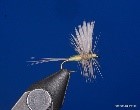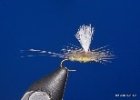Fly Fishing Starter Flies
Beginners to fly tying are often surprised to learn that the term “fly” is mainly generic. While some fly fishing starter flies do resemble flying insects, other beginner flies are designed to mimic the appearance and motion of fish food like baitfish, leeches, worms, crustaceans and scuds.
Beginner Flies Categories
The lures fly anglers use to catch fish are designed to duplicate the immature and adult stages of terrestrial and aquatic insects such as mayflies, caddisflies, stoneflies, damselflies, dragonflies, midges and others.
When it comes to determining the “easiest” fly fishing starter flies to begin with, the answers tend to be as varied as the anglers. However, one vital piece of advice for making beginner fly fishing flies that seems to be shared among all the various experts is this: tie a fly that you can fish with. There is no point in making a bunch of trout flies, no matter how easy the pattern, if the only targets around are panfish.
Most of the best fly fishing flies fit into three basic categories: dry flies, nymphs, and streamers. When you visit a fly shop or browse through a mail-order catalog, you will usually find these different flies for fly fishing displayed or listed by their categories.
Dry Flies Fishing Starter Flies

Dry flies float on the water's surface and imitate a wide range of foods, including adult mayflies, caddisflies, midges, grasshoppers, crickets, ants and many others. While the newest type of fly, dry flies have become so popular that there are now subcategories to describe the various types of dry flies:
Traditional dry flies keep the hackle tied around the hook which allows the fly to sit slightly off the water. Good for fast, choppy waters where the hackle tips can assist with floatation.

Parachute dry flies tie the hackle around a vertical post, which allows the fly to sit directly on the water. Also effective in fast, choppy waters, however, its lower profile may make strike detection more difficult.
Comparadun dry flies forgo the hackle and instead use deer hair to mimic the wing. Like the parachute fly, it also sits flush on the water but is preferred in slower waters.

The magic of seeing a trout, bass or panfish take a dry fly floating on the surface of the water is one of the most exciting thrills in fly fishing. Deer-hair bass bugs and poppers, used for largemouth and smallmouth bass and panfish, are also dry flies because they float on the surface.
Examples of popular dry beginner flies include the Adams fly, brassies and several caddis variations.
Nymphs/Wet Fly Fishing Starter Flies
Nymphs and wet flies represent the immature life stages of insects such as mayflies, caddisflies, stoneflies and others. These flies are fished below the water's surface and usually work best just prior to a hatch of water-born insects, when the nymphs and pupae that they represent become active.
Some special nymphs that imitate the emerging adult insect are fished just below or in the water's surface film. Called emergers, these flies are half wet and half dry; but because they don't float on top of the surface film, we'll include them with the nymphs and wet flies.
Among beginner flies, the Pheasant Tail Nymph is considered a staple fly to have in all gear boxes.
Streamers
Streamers are somewhat larger flies that represent minnows, sculpins, leeches and other swimming food items that provide meals for bass, trout, panfish and saltwater fish such as tarpon, redfish, bonefish and striped bass. Although all fish, regardless of size, will strike streamers, these flies are well known for their ability to take the largest fish in streams, ponds, lakes and saltwater.
While the most popular streamer regardless of experience level is the Woolly Bugger, the easiest to tie may be the San Juan worm.
Fly Sizes
Fly sizes are referred to by a number that denotes the size of the hook on which the fly is tied. For most trout flies, the larger the number, the smaller the fly. For example, a size 18 Adams (#18 Adams) is smaller than a size 12 Adams. In sizes smaller than #2, sizes are represented by even numbers, so in our example there is a difference of four hook sizes between the #12 and #18 Adams. Extremely large hook sizes are noted with "ought" sizes, such as 1/0 (called "one-ought" or "one-oh" in fly fishing terminology).
Hook Sizes
For any hook size, the hook-shank length can be standard, extra-long or extra-short. Extra-long (noted as XL on hook specifications) and extra-short (XS) shanks are given in multiples of standard shank length, such as 1XS or 4XL. Hook wire is also available in extra-fine and extra-heavy sizes.
One of the quirks of hook terminology when it comes to hook sizes concern how large hooks with a /0 size designator are numbered. Like conventional hooks, the larger the number ahead of the slant bar, the larger the hook (e.g., a size 5/0 hook is larger than a size 2/0). However, unlike the smaller hooks that only come in even numbers, the /0 hooks increase in size by one number at a time (e.g., sizes #2/0, #3/0, #4/0, #5/0, etc.).
These bigger hooks are usually used for bass and saltwater flies, but fishermen who stalk large trout sometimes use these sizes, too, especially when tying streamers.
KEEP LEARNING

How to Tie the Non-Slip Loop Knot
The non-slip loop knot is a popular and reliable choice for securing hooks, lures, and other tackle to your fishing line.
LEARN MORE

Socials
Take me fishing social media links
LEARN MORE

TakeMeFishing x Teen Vogue
Join us on a creative journey as fashion designer Ahmrii Johnson walks us through her collaborative vision and process with Teen Vogue and fashion brand, Rentrayage, to create a special piece.
LEARN MORE


.png?lang=en-US&ext=.png)